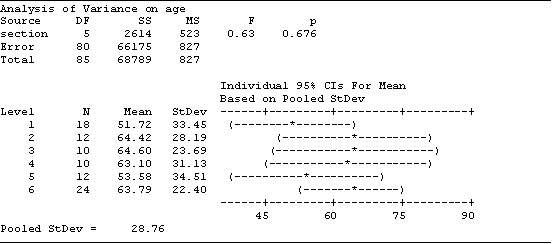 |  Research Projects in Statistics Joseph Kincaid,
Blue Cross and Blue Shield of Kansas City
Data Analysis
Project ExamplesData Analysis
Data Analysis Report for Growlithe Group
This project had three variables: sex, age at death and section of the cemetery. The data was prepared by putting each variable into a column with a row of the data representing a single observation.
In this example, the section is a block variable that may affect the results. This would happen, for example, if one of the sections was designated for a certain demographic such as children or residents of a local nursing home. Our initial analysis should answer this question before going on.
Although the sections are recorded as numbers, the variable is really a nominal variable. Therefore, an analysis of variance of age on section is appropriate to determine whether the age at death is related to the section.
 <a onClick="window.open('/olcweb/cgi/pluginpop.cgi?it=jpg::::/sites/dl/free/0072946814/121311/ch06_1.jpg','popWin', 'width=NaN,height=NaN,resizable,scrollbars');" href="#"><img valign="absmiddle" height="16" width="16" border="0" src="/olcweb/styles/shared/linkicons/image.gif"> (52.0K)</a>
The hypotheses for this analysis are H0: the age is not related to section and H1: the age is related to section. Because the P-value is high (0.676), we cannot reject the null hypothesis that age is not related to section. Therefore, we will disregard section in further analysis.
The research question seeks to compare the age of death of males vs. females in this cemetery. This comparison can be answered from this data by setting up the right hypotheses and carrying out the appropriate analysis.
The hypotheses are: <a onClick="window.open('/olcweb/cgi/pluginpop.cgi?it=jpg::::/sites/dl/free/0072946814/121311/ch06_1.jpg','popWin', 'width=NaN,height=NaN,resizable,scrollbars');" href="#"><img valign="absmiddle" height="16" width="16" border="0" src="/olcweb/styles/shared/linkicons/image.gif"> (52.0K)</a>
The hypotheses for this analysis are H0: the age is not related to section and H1: the age is related to section. Because the P-value is high (0.676), we cannot reject the null hypothesis that age is not related to section. Therefore, we will disregard section in further analysis.
The research question seeks to compare the age of death of males vs. females in this cemetery. This comparison can be answered from this data by setting up the right hypotheses and carrying out the appropriate analysis.
The hypotheses are:
H0: the mean age of males is equal to the mean age of females
H1: the mean age of males is different from the mean age of females
The appropriate analysis for this is a two-sample t-test. The test is carried out below.
 <a onClick="window.open('/olcweb/cgi/pluginpop.cgi?it=jpg::::/sites/dl/free/0072946814/121311/ch06_2.jpg','popWin', 'width=NaN,height=NaN,resizable,scrollbars');" href="#"><img valign="absmiddle" height="16" width="16" border="0" src="/olcweb/styles/shared/linkicons/image.gif"> (26.0K)</a>
From the high P-value (0.60), we see that this is not enough evidence to reject the hypothesis that men and women are generally the same age at death.
Next, confidence intervals will be calculated to estimate the average age at death for men and women. Based on the results of the hypothesis test, we expect the intervals to overlap quite a bit. <a onClick="window.open('/olcweb/cgi/pluginpop.cgi?it=jpg::::/sites/dl/free/0072946814/121311/ch06_2.jpg','popWin', 'width=NaN,height=NaN,resizable,scrollbars');" href="#"><img valign="absmiddle" height="16" width="16" border="0" src="/olcweb/styles/shared/linkicons/image.gif"> (26.0K)</a>
From the high P-value (0.60), we see that this is not enough evidence to reject the hypothesis that men and women are generally the same age at death.
Next, confidence intervals will be calculated to estimate the average age at death for men and women. Based on the results of the hypothesis test, we expect the intervals to overlap quite a bit.
 <a onClick="window.open('/olcweb/cgi/pluginpop.cgi?it=jpg::::/sites/dl/free/0072946814/121311/ch06_3.jpg','popWin', 'width=NaN,height=NaN,resizable,scrollbars');" href="#"><img valign="absmiddle" height="16" width="16" border="0" src="/olcweb/styles/shared/linkicons/image.gif"> (21.0K)</a> <a onClick="window.open('/olcweb/cgi/pluginpop.cgi?it=jpg::::/sites/dl/free/0072946814/121311/ch06_3.jpg','popWin', 'width=NaN,height=NaN,resizable,scrollbars');" href="#"><img valign="absmiddle" height="16" width="16" border="0" src="/olcweb/styles/shared/linkicons/image.gif"> (21.0K)</a>
Thus, the average age at death of all males in the cemetery is believed (with 95% confidence) to be between 54 and 69 and the average age at death of all females in the cemetery is believed (with 95% confidence) to be between 48 and 68.
|
|



 2004 McGraw-Hill Higher Education
2004 McGraw-Hill Higher Education

 2004 McGraw-Hill Higher Education
2004 McGraw-Hill Higher Education